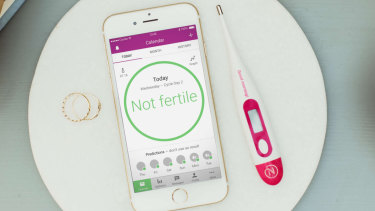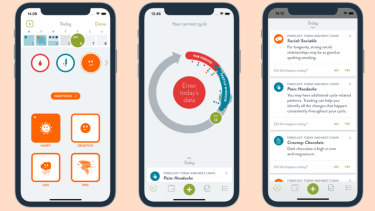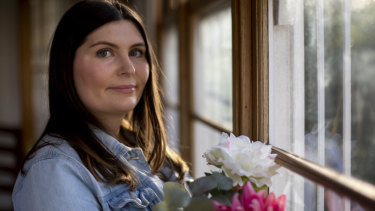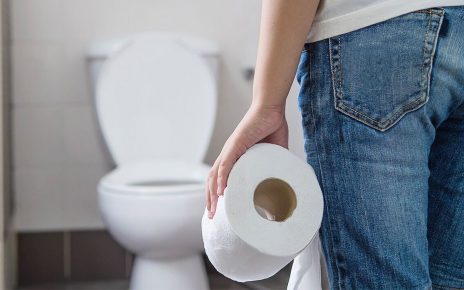The pain was unbearable. Migraines were tormenting Zoe*, 26, at least once a week, sometimes twice, leaving her unable to function for up to three days at a time.
With the help of a GP, she tried a variety of treatments, but nothing worked. She felt herself becoming dangerously reliant on painkillers. Eventually, she decided to try quitting the contraceptive pill – not on the advice of her doctor, but because she’d read research linking it to migraines.
Natural Cycles is a fertility tracking app and so-called “digital contraception”.
In its place, she downloaded an app to track her fertility. Every day, Zoe's phone would tell her if she could have unprotected sex with her long-term partner based on where she was in her menstrual cycle.
Almost immediately the migraines went from twice a week to once a month. Then, after about six months, they stopped altogether. “I can’t remember the last time I had one,” she says.
Most Australian doctors say fertility tracking apps shouldn’t be relied on for birth control, especially if pregnancy would be devastating for the person, as there is too much room for error.
But, while the Millennial women who use these apps acknowledge it’s not for everybody, for them, the benefits of no longer experiencing side-effects from the pill have made it worth taking the leap.
How do fertility tracking apps work?
Zoe is part of a growing number of Australians looking to “natural” methods of contraception. A 2017 Monash University survey of sexually active Australians found 15 per cent used hormone-free contraception methods, such as withdrawal and fertility awareness, double the figure recorded in previous studies.
While the smartphone technology is new, it's premised on fertility awareness, one of the oldest forms of contraception – and the only one approved by the Catholic Church.
It involves charting your menstrual cycle on a calendar or observing fertile symptoms such as slight changes in body temperature or cervical mucus. This helps determine a woman's fertile window – the time in the menstrual cycle when she is ovulating and most likely to conceive.
What are fertility awareness-based methods of contraception?
- They involve tracking your menstrual cycle and avoiding unprotected sex around the time of the month where you are likely to be ovulating and therefore most fertile
- Ways to work out the fertile window including charting period dates on a calendar (ovulation happens about 14 days before a period starts); taking daily body temperature (it rises slightly just after ovulation); monitoring cervical mucus (it is watery and slippery when fertile)
- The fertile window is usually about a week long, as an egg lives about a day after ovulation and sperm can live about six days after sex
- With typical use, 75 per cent effective at preventing pregnancy
- Effectiveness can be 99 per cent with perfect use and when combining at least two tracking methods
- No STI protection
During this period, couples must either abstain from sex or use condoms. Outside of it, they can have sex unprotected.
With "femtech" expected to be worth $US50 billion ($71 billion) by 2025, fertility tracking apps have mushroomed quickly. In the App Store's health and fitness category, the number of period trackers is second only to running apps.
A quick search delivers dozens of results, most with cute names – like Clue, Flo, Ovia, Dot, Glow – and pink logos that purr "meet your new best friend".
But many of these are primarily marketed as helping women predict when they are due to menstruate or ovulate, despite women using them as a way to help them avoid pregnancy.
In contrast, Swedish startup creation Natural Cycles bills itself as "digital contraception"; it's the first app to be certified as a contraceptive by European Union health authorities and by the FDA in the US.
The Clue app is another popular fertility tracker.
Natural Cycles has not been approved by Australia's Therapeutics Goods Administration as a medical device (consumers are urged to "exercise caution" with products not reviewed by the TGA), but it is still available to be downloaded. Here, it calls itself a “birth control app” while stating it is not intended for that purpose in Australia. But, of course, that can't be controlled.
Zoe pays $12 a month for the app, which combines the calendar and temperature methods of fertility awareness.
She is what the app's founders would call a “typical user”: she has a regular weekly schedule, is aged 25-35 and has been in a long-term relationship.
Her tasks are to enter her menstruation dates into the app and use a thermometer every morning before getting out of bed. An algorithm then crunches her data and predicts where she is in her menstrual cycle. Each day on her calendar is then marked either green, meaning it’s safe to have unprotected sex, or red, meaning it’s time to abstain or use condoms. She says she gets about 10-12 of the latter in each cycle.
'You have a one in four chance of getting pregnant this year'
Family Planning Alliance Australia ranks fertility-awareness-based methods of contraception as among the least effective ways to prevent pregnancy.
They are said to be about 75 per cent effective with typical use, but can be as high as 99 per cent with perfect use. This means for every 100 women using a fertility app, anywhere between one and 25 could fall pregnant this year.
One key issue is these methods rely on women being hypervigilant about observing and recording their symptoms each day, and using condoms when in the fertile window.
Dr Catriona Melville, deputy medical director at Marie Stopes, doesn’t believe everyone is capable of applying fertility-awareness-based methods correctly. “If you use it perfectly, and you check your mucus, and take your temperature, and mark your calendar, and you use it all perfectly, it can have a very low failure rate. But you have to be absolutely motivated to use it exactly right,” she says.
For example, your temperature must be taken before stepping out of bed every morning, and around the same time every day. If you get sick, have a hangover, work late, sleep in, get stressed or simply go to the toilet right after waking up, that day's result will be flawed.
Because of such complexities, Dr Melville says, in her experience, most women are only entering their menstrual cycle on the calendar, despite being advised to track at least two fertility indicators to increase effectiveness. “That, to me, is Russian roulette. You have a one in four chance of getting pregnant this year.”
And then there’s the fact menstrual cycles can fluctuate.
“Some women who feel they have a quite a reliable cycle might have a lot of confidence in these methods, but you occasionally ovulate earlier or later,” warns Dr Suzanne Pearson, senior medical educator at Family Planning Victoria.
Most women are only entering their menstrual cycle on the calendar, despite being advised to track at least two fertility indicators to increase effectiveness.
Anyone with an irregular cycle shouldn't use the apps, says Sydney GP Dr Brad McKay, who is firmly against the idea of so-called "digital contraception".
“[Even if] you’ve got the wind blowing in the right direction for you, there will still be an amount of people this will fail for.”
After a decade on the pill, Mary, 30, fell pregnant seven months into using a fertility tracking app.
For the first few cycles she was very careful, but then became “overconfident” she says. “I started being less strict with temperature taking and just started assuming the middle part of my cycle was when I was fertile.”
Mary says she was shocked when she fell pregnant with her first child while using a fertility tracking app.Credit:Tammy Law
She says she was “super shocked” when she got pregnant. “I was in a committed and happy relationship and … we had discussed the possibility of kids, it just happened a lot earlier than planned.”
Today, Mary doesn't consider the apps to be a form of contraception. “Back then I felt it was … Tracking cycles to prevent pregnancy is literally something women have been doing forever, there’s just a lot more room for error and mistakes compared to other modern forms.”
There is little research on these apps, and what exists shows mixed results. In 2016, a study from Columbia University examined 1116 free fertility tracking apps and found only 20 accurately predicted ovulation. Research from Georgetown University in 2015 looked at 30 apps that predicted a fertile window and found only six were accurate.
But the scientist husband-and-wife team who created Natural Cycles has been working hard to prove their app's effectiveness. Clinical studies published in peer-reviewed journals claim it is 93 per cent effective at preventing pregnancy with typical use – similar to imperfect use of the oral contraceptive pill (perfect use of the pill is usually cited as 99 per cent, the same figure claimed by Natural Cycles).
Natural Cycles was created by Dr Elina Berglund and her husband Dr Raoul Scherwitzl.
Co-founder Dr Raoul Scherwitzl says there in an unmet need for effective hormone-free contraception, and “that is not to be ignored”.
“By increasing choice in the non-hormonal space, we shift users from less effective methods such as withdrawal [and] condom alone,” he says.
Dr Scherwitzl acknowledges there are more effective hormonal methods, such as an implant or IUD, and he recommends these to women where the effectiveness rate is the biggest deciding factor for choosing their birth control method.
Which, for some people, it isn’t.
Kayleigh*, 29, replaced the contraceptive pill with the app Clue 15 months ago and, while she feels “quite protected”, she says one of the key reasons she uses the app is because "an accidental pregnancy wouldn’t be the end of [her] world".
“I have a great job, paid maternity leave, and I’m in a stable, committed relationship. I’m not sure I could stop using hormonal birth control completely if I wasn’t in the position I am in.”
'I would cry at the drop of a hat'
The popularity of fertility apps really comes down to the most popular alternative: the peppercorn-sized pills women have been swallowing every day for the last six decades.
The pill can have crippling side-effects. Kayleigh was on the pill for 12 years but eventually began suffering acne breakouts, no libido, pain after sex and depressive episodes. “I would cry at the drop of a hat and I knew I was being irrational but I couldn’t stop," she recalls.
Now, Kayleigh tracks her period, temperature and cervical mucus and no longer has any side-effects.
“I feel more myself than I ever have. I actually have a sex drive now. I feel so much more in tune with my body. I’m happy, I don’t have down days anymore. I don’t remember a time since coming off the pill where I have had an irrational emotional outburst.”
An accidental pregnancy wouldn’t be the end of [my] world
Nina* has generalised anxiety disorder. She says going off the pill sparked a sudden drop in her symptoms. “When I was on the pill I had less control of my emotions, was crying easily, had more frequent panic attacks. I also experienced fairly debilitating migraines,” she says.
The 25-year-old Melbourne woman also uses the Clue app, and says she now feels empowered – a sentiment echoed by most women interviewed for this story. “I love understanding my cycle and … feeling in tune with my body, and I actually feel more in control now.”
For others, the impetus for stopping the pill can be as simple as wanting to better understand how it may or may not be affecting them.
“I decided to stop the pill because I hated not knowing what my body was doing on its own terms,” says Katie*, 26. Now, she says she feels “a lot more content”.
It seems there is a shift occurring: women are beginning to question the very pill that marked the beginning of their sexual liberation, that gave them control over their reproductive futures, and that propelled pushes for stronger female workforce participation, better childcare and equal pay for equal work.
Now, women want to know how the revolutionary drug is changing their bodies and minds – no matter how big or small.
Dr Melville says over the last few years she has seen an increase in women expressing angst about the hormones in contraception. This, partly, can be put down to today’s obsession with all things wellness and organic. “It’s like it is coming out of this desire for clean living, which I’m a complete advocate for, we don’t want to fill our bodies with things we don’t have to,” Dr Melville says.
There is a fear this is partly coming from a more general distrust of modern medicine – a scepticism which created the dangerous anti-vaxxer movement. But it seems unfair to liken these women to the anti-vaxxer community; not just because contraception is a deeply personal issue, but also because maintaining herd immunity has broader implications.
Women have carried the responsibility of contraception ever since the pill’s inception, and now have a brimming menu of not-quite-perfect options, from implants to injections, IUDs to diaphragms. Meanwhile, a male contraceptive pill remains a fantasy.
The pill has proven to cause side-effects of varying degrees including depression, anxiety, bloating, nausea, migraines, decreased libido, weight gain and blood clots.
Of course, not all women experience unpleasant side-effects. Most do not. But that’s the thing with hormones; people react differently.
A question of choice
Women are now more savvy about their physical and mental health than ever before. According to Texas Christian University's Professor Sarah Hill, who wrote the book This Is Your Brain On Birth Control, it is a positive step for women to interrogate a drug that has been mindlessly consumed for years.
“The pill has been an amazing force in women’s lives. However we are now at a point when we should start having thoughtful conversations about the ways that the pill changes us,” says Dr Hill, who felt more "vibrant and alive" after she quit the pill. “This doesn’t mean we need to stop using the pill. It just means we should know about the psychological trade-offs that we are making when we are on it.”
Dr Melville agrees choice is important, so long as women are aware of the risks in opting for hormone-free tracking apps. “This might be part of a movement of women taking control of their bodies and fighting back a bit. They’ve been taking these hormones for years and they want to try something different. I completely understand that. But equally you don’t want to end up with unplanned pregnancy or an STI,” Dr Melville says.
“I’m a big believer in choice for women and women have to use a method they’re going to engage with and feel comfortable with, but it's important they know that, with typical use, these methods are less effective."
We are now at a point when we should start having thoughtful conversations about the ways that the pill changes us.
Dr Pearson says she has a lot of sympathy for women who experience side-effects from the pill, but an unwanted pregnancy can be far more distressing. She says there are many other contraceptive options available, including the hormonal IUD or implant which release hormones in lower doses, or the hormone-free copper IUD. Each of these are said to be 99 per cent effective.
“Don’t lump all hormonal contraceptives into one basket because there are significant differences not just in hormones but also doses and administration, which can make a big difference to side-effects,” she says.
Ultimately, some women are going to decide to use fertility tracking apps as their contraceptive; what works for one woman won’t necessarily work for another.
“There is no such thing as a 'one size fits all' plan for fertility regulation … We need to support each other and have an open dialogue about the struggles associated with regulating our fertility. It’s the first step in asking for something better,” Dr Hill says.
*Surnames withheld on request
Source: Read Full Article







